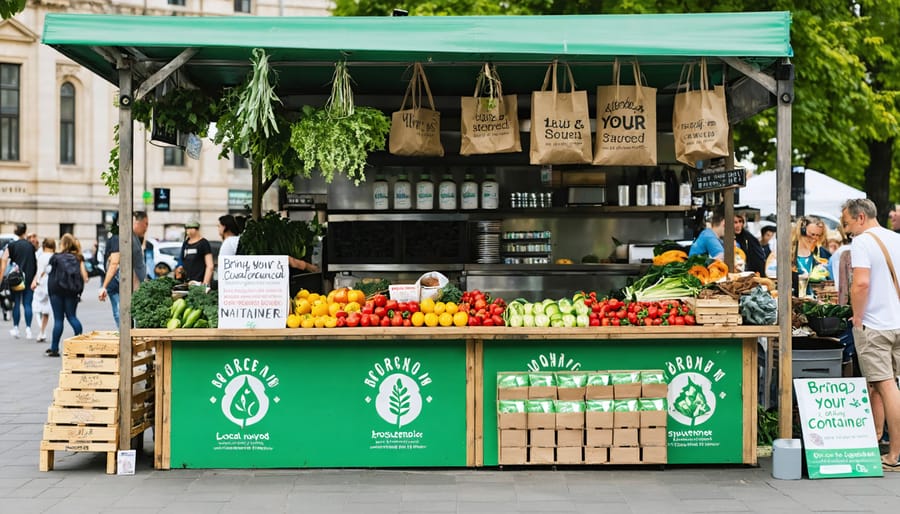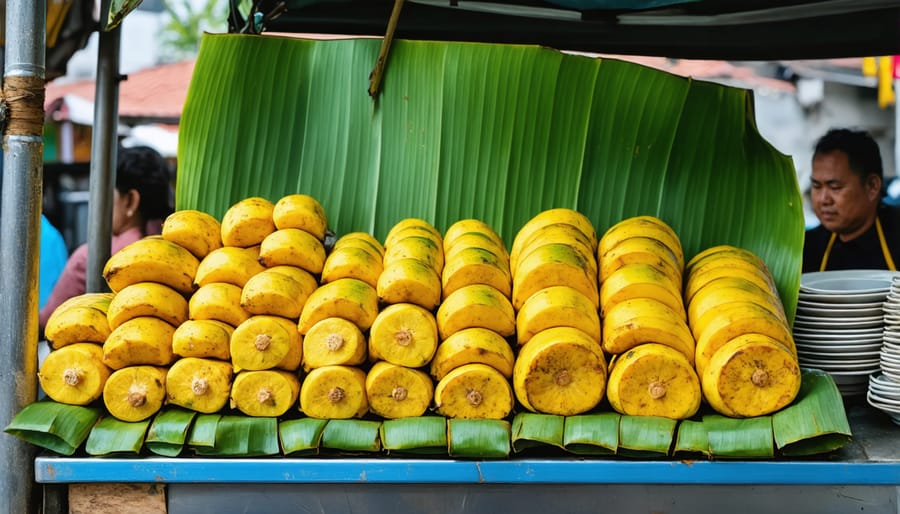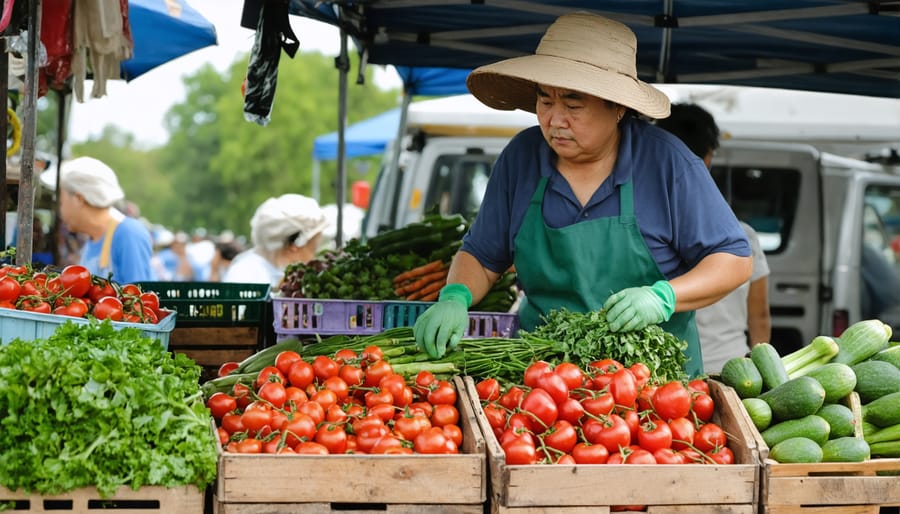
Transform your relationship with food by embracing sustainable practices that nourish both your body and our planet. Every meal presents an opportunity to make choices that ripple through our global food system, from farm to table and beyond. The way we grow, choose, prepare, and dispose of our food shapes not just our health but the vitality of entire ecosystems and communities.
In an era where convenience often trumps consciousness, sustainable food practices offer a powerful way to reconnect with our food sources while protecting precious environmental resources. Whether you’re a seasoned farmers’ market enthusiast or just beginning to explore eco-friendly eating, small, mindful changes in your daily food habits can create meaningful impact.
From reducing food waste through creative cooking and proper storage to supporting local farmers who use regenerative agriculture techniques, sustainable food practices aren’t just trends – they’re essential tools for building a resilient food future. The beauty of sustainable eating lies in its accessibility; every person, regardless of location or budget, can take steps toward more environmentally conscious food choices.
Join a growing movement of mindful eaters who understand that sustainable food practices aren’t about perfection – they’re about progress, connection, and caring for our shared planet one meal at a time.
The Hidden Environmental Impact of Street Food
From Packaging to Food Waste
Last week at my favorite taco stand, I noticed something that made my heart sink – a mountain of disposable containers piling up in just one afternoon. It’s a scene that plays out across street food venues everywhere, highlighting one of our biggest sustainability challenges. While these vendors bring us amazing flavors and cultural experiences, the packaging footprint can be substantial.
From disposable utensils to single-use containers, the average street food vendor can generate significant waste. But here’s the good news: many vendors are embracing zero-waste practices by switching to biodegradable packaging or encouraging customers to bring their own containers.
Food waste is another crucial concern. While street food traditionally helps reduce waste through made-to-order preparation, factors like unpredictable customer flow can lead to surplus ingredients. I’ve seen creative solutions emerging, like vendors using apps to sell leftover portions at discounted prices or partnering with local composting initiatives.
As customers, we can support these efforts by carrying our own reusable containers and being mindful of our ordering habits. Remember, every small choice adds up to meaningful change!

The Carbon Footprint of Mobile Kitchens
Last week, while chatting with Maria, a local food truck owner, I discovered just how complex the carbon footprint of mobile kitchens can be. These beloved street food venues face unique sustainability challenges, but they’re also pioneering creative solutions.
The average food truck runs on generators or grid power, consuming significant energy for cooking, refrigeration, and lighting. A typical truck might use 30-40 gallons of fuel per week just for power generation. However, I’ve noticed more vendors switching to solar panels for basic electricity needs and investing in energy-efficient appliances.
What’s encouraging is how many food truck owners are embracing eco-friendly practices. Some use hybrid vehicles for transportation, while others have mastered the art of minimal water usage through innovative cleaning methods. I recently met a vendor who composts all their food scraps and uses biodegradable packaging exclusively.
The good news? These sustainable choices often lead to cost savings. By reducing energy consumption and waste, mobile kitchen operators not only help the environment but also improve their bottom line. It’s a win-win that proves sustainability and successful street food business can go hand in hand.
Smart Solutions from Street-Smart Vendors
Eco-Friendly Packaging Revolution
Remember when takeout meant a mountain of plastic containers and guilt? Those days are finally changing! As someone who’s passionate about eco-friendly food practices, I’m thrilled to see the incredible innovations in sustainable packaging taking over our food scene.
Today’s food vendors are embracing amazing alternatives like containers made from bamboo fiber, which naturally decompose within months. I recently discovered a local café using containers crafted from compressed wheat stalks – they’re sturdy enough for hot soup yet completely biodegradable! These earth-friendly options are giving traditional plastic packaging a serious run for its money.
The reusable revolution is equally exciting. Many restaurants now offer loyalty discounts when you bring your own containers, and some have even started “container libraries” where you can borrow vessels and return them later. My favorite breakfast spot uses a brilliant system of stainless-steel containers with a deposit scheme – it’s like the modern version of the milkman delivery!
What really warms my heart is seeing how enthusiastically our community has embraced these changes. From collapsible silicone containers that fit perfectly in your bag to beeswax wraps replacing plastic film, we’re proving that convenience doesn’t have to cost the Earth. Even simple switches like biodegradable cutlery made from avocado seeds show how innovation and sustainability can go hand in hand.

Local Sourcing Success Stories
The heart of sustainable food practices beats strongest in local partnerships, and I’m thrilled to share some inspiring success stories from our community. Take Sarah’s Fresh Kitchen, a popular café that transformed its supply chain by partnering with five family farms within a 50-mile radius. Not only did their carbon footprint shrink dramatically, but their signature avocado toast now features the creamiest locally grown avocados you’ve ever tasted!
Another game-changer is The Green Table, a restaurant that implemented innovative seasonal sourcing strategies by creating a rotating menu based entirely on what’s available from local farmers. Their “Farm-to-Fork Fridays” have become so popular that they’ve inspired three other restaurants in the area to adopt similar practices.
The Downtown Farmers’ Collective is perhaps my favorite example. This group of 15 restaurants pooled their resources to create a shared purchasing system with local farmers. By guaranteeing consistent orders, they’ve helped four small farms expand their operations and switch to organic practices. The result? Fresh, sustainable ingredients delivered daily, with food traveling an average of just 30 miles from farm to plate.
These partnerships aren’t just feel-good stories – they’re proven business models that show how local sourcing can create a ripple effect of positive change throughout our food system.

Making Sustainable Street Food Work for Everyone
Small Changes, Big Impact
Making our food practices more sustainable doesn’t require a complete overhaul of operations. In fact, some of the most impactful changes are surprisingly simple! I learned this firsthand when chatting with Maria, a local food truck owner who transformed her business with just a few thoughtful adjustments.
Start with portion control – it’s a game-changer. Using standardized scoops and measuring tools not only reduces food waste but also helps maintain consistent pricing. Consider switching to reusable or biodegradable containers and encouraging customers to bring their own containers by offering small discounts.
Smart sourcing is another easy win. Partner with local farmers and suppliers to reduce transportation emissions while supporting your community. I’ve seen vendors create lasting relationships that benefit everyone – from farm to food stall to customer.
In the kitchen, small changes add up quickly. Install water-efficient faucets, use energy-saving appliances, and create a composting system for food scraps. One vendor I know started collecting coffee grounds for local gardeners, turning waste into a community resource!
Remember to communicate these changes to your customers. A simple chalkboard listing your sustainable practices can inspire others and create meaningful conversations about environmental responsibility. It’s amazing how these seemingly small adjustments can ripple through the community, creating positive change one meal at a time.
Supporting Sustainable Street Food
Street food has always been close to my heart – there’s something magical about the way it brings communities together. But as I’ve become more conscious about my sustainable food choices, I’ve discovered simple ways we can enjoy these culinary treasures while being kind to our planet.
Start by bringing your own reusable containers and utensils. I keep a small set in my bag, and vendors often appreciate customers who help reduce waste. Look for stalls that use biodegradable packaging or, better yet, traditional banana leaves or paper wrapping – these vendors are already taking steps toward sustainability.
Choose local and seasonal ingredients when possible. If a vendor offers mangoes in winter, they’re likely imported. Instead, opt for what’s naturally available in your area. I’ve found some of my favorite street food discoveries this way!
Support vendors who source ingredients from local farmers or grow their own produce. Ask questions about where their ingredients come from – most are happy to share their stories. Many street food vendors are already sustainability champions without even realizing it, using traditional preservation methods and whole-ingredient cooking.
Remember, small changes add up. Whether it’s choosing plant-based options occasionally or saying no to unnecessary plastic bags, every conscious choice helps create a more sustainable street food culture. Plus, these conversations with vendors often lead to wonderful connections and a deeper appreciation for our food community.
As we’ve explored together, street food isn’t just about satisfying our cravings – it’s becoming a powerful force for sustainable food practices in our communities. From vendors using locally sourced ingredients to customers bringing their own containers, these small changes are creating ripples of positive impact in our food culture.
I’m reminded of Maria, a local taco vendor who transformed her business by switching to compostable packaging and partnering with nearby farms. Her story, like many others, shows that sustainable street food isn’t just good for the planet – it’s good for business too.
We all have a role to play in this movement. Next time you’re enjoying your favorite street food, consider bringing your own container, asking about ingredient sourcing, or simply starting a conversation about sustainability with the vendor. These small actions, multiplied across our community, can lead to significant change.
Remember, sustainable food practices aren’t about perfection – they’re about progress. Whether you’re a regular street food enthusiast or an occasional visitor, your choices matter. Let’s support vendors who prioritize sustainability and encourage others to join the movement.
Together, we can transform our street food culture into a model of sustainable dining that nourishes both our communities and our planet. Start with one small change today – your future self (and our planet) will thank you for it.



